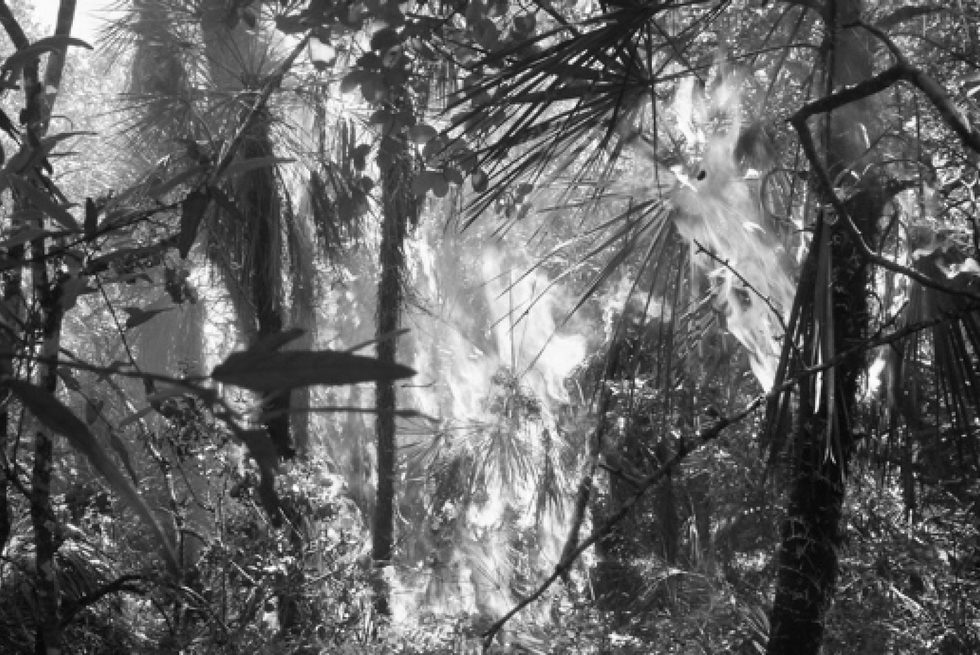Good People
From the Series: Bateson Book Forum: Behold the Black Caiman
From the Series: Bateson Book Forum: Behold the Black Caiman

The Black Caiman is a figure of the once dark, abundant waters of the Gran Chaco region, a figure associated with the spiritual world of death and inversion. In the white heat and dust of cattle-razed lands and Ayoreo encampments, a Caiman walking through a campsite is a portent of death and violence. Its absence during Lucas Bessire’s ten years of fieldwork, coupled with his deepening relationship with place and people, leads him to refigure the Black Caiman as the multifold, undeviating violence that stalks the people he has come to know.
Behold The Black Caiman is thus a witnessing of the way violence unfolds, is enacted toward, received by, and remade into the suffering of the Ayoreo of northern Paraguay and Bolivia. As Bessire describes, the Ayoreo can be slaughtered, wasted, converted, studied, and governed as vanishing subhuman residue because of the ways they are seen as primitive—as previously uncontacted, brown-skinned people, emerging in bands from the forests beginning in the mid-twentieth century—and also as ex-primitive—their traditional forms and forces degraded by repeated contact with the modern, their lives no longer of service to governing, civil, and expert bodies seeking to legitimize their own operations.
The political implications of Bessire’s work are far-ranging, as the book reflects on the kind of movement, paradox, and disorder that we must come to recognize and evaluate as life if we are to become a world interested in the stakes of increasingly uneven social, political, and economic landscapes. “Apocalypse and the Limits of Transformation,” for example, is a chapter that contextualizes contemporary Ayoreo Christian faith practices as a consequence of cycles of terror and suffering that marks the shift from the Erami forest-world to the Cojñone-Gari (That-Which-Belongs-to-the-Strangers). Contact and religious conversion drive rupture and yet Bessire interrupts the notion of any clean erasure of the complex sensemaking capacities of Ayoreo. Instead, he calls us to see how apocalyptic visions make absolute sense when world-ending violence characterizes one’s everyday. When salvation comes in the form of humanitarian aid as offal byproduct of the billion-dollar Bolivian cattle industry, dumped off the back of a truck once a week onto the ash of earth that is the Ayoreo encampment, Bessire can ask, earnestly, if there is any actual deliverance in identifying the adoption of eschatological belief as the regrettable loss of native tradition or the contamination of a once-pure form of cosmological alterity. He can ask what we are doing, translating life this way.
Thus, alongside an appeal for the humanity of Ayoreo to be recognized, Behold the Black Caiman demands the renovation of the way in which anthropology continues its search for the primitive, folding back time and time again on the tried and tired theories that bind alterity to the total ontological difference of the native primitive. He shows that to attempt to humanize by creating a cohesive, ordered understanding of an other is an act of violence. In the case of the Ayoreo, this violence is an overruling of the efforts of Ayoreo to remake themselves amidst the already brutal, rotational violence that they daily experience. If I am reading correctly, Bessire’s appeal thus asks us to sift through and examine our attachments to a manner of seeing driven by the mistaken notion that to reinstantiate a concretized version of the primitive past is to enable a hopeful future for others and for ourselves. Bessire asks us to stop in our tracks, to notice if we are the skin of the postmulticultural conceit, a surface that conceals a space where an ex-primitive can be pushed aside while the colonial fantasy—and discovery—of a real primitive is celebrated via humanitarian, NGO, governmental, and international realms. It asks us to check whether we are the Black Caiman, walking through.
For all the deep political work that Behold the Black Caiman does, especially in its critique of misapprehensions in the field of anthropology, there is a quiet bow to the complications, vastness, geographies, and temporalities of the methods of anthropology, too. There is an invitation to be with the contingencies of seeing that depend on what is caught in us at the points we enter the field, on the field of our vision that is our ability to know and unknow, on what we make of the social habits of a world that we keep trying to undo, especially when we find that it forms parts of us. In the transparency of Bessire’s own uneven and skillful field experience comes a work of art redemptive of the ethnographic form: a manner of translation that is shown to be thick enough to allow space in which life might be fought for, and held.
The feeling that comes upon reading this work tells me that we are in this together, whether we know it or will be made to know it. It reminds me of the feeling I had when I first happened upon anthropology as a possibility in the world: that there was something beautiful and important in what could occur through the intimate and prolonged exchange of people with each other. It was a feeling that rose again when, just before the first introduction to anthropology class of the year the professor pulled the several TAs aside: Our goal is not to make anthropologists, I remember her saying. Our goal is to make good people. This book, to me, is a similar kind of opening: a long moment in which the potential of the anthropological endeavor finds us and waits for our arrival.
Contributor GeneratedPUBLISHED ONJune 9, 2016CITE ASIwashita, Ann. "Good People." Dialogues, Cultural Anthropology website, June 9, 2016. DialoguesCREATED" class="redactor-autoparser-object">https://culanth.org/fieldsights/890-good-peopleCONVERSATION
CREATED BYAnn IwashitaSHARE



Comment